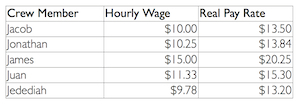Think about your delivery crew and their wages. Write down each of them and their respective pay rate. While you’re at it, you’ll want to remember the costs you have in addition to their paychecks; things like taxes, payroll fees, worker’s compensation insurance, benefits, etc.

Check with your bookkeeper, account, or payroll service to determine what the real rate of pay is for your staff and crew (they can determine this by looking at your historical data and crunching some numbers). In our case, we’ll work with the figure 1.35 times the hourly wage. That means if we pay a crew member $10 per hour, our real cost is $13.50 per hour.
Your list might look something like this:

Now let’s think about how much time it will take our crew to prep the order (including cleaning, wrapping, packaging, etc.) and load it in the truck.
In this case, we’ll call it half an hour. For the sake of simplicity, we’ll also consider that unloading at the venue, reloading at the venue after the event, and unloading back at the warehouse will also be half an hour.
If the time is actually quite different at each load/unload point, you’ll want to keep this in mind. For instance, if it will really take 0.5 hours to load, 1 hour to unload, 1 hour to reload, and 0.5 hours to unload again, you’re talking about a total time of 3 hours.
But for our situation, we’ll talk about 2 hours total. That’s two hours per employee, however, and we need two guys on this job.
We’re up to a total of 4 man hours now just for the loading, unloading, etc.
Now let’s think about the travel time. Before we move forward with this step, you’ll want to chat with your accountant about paying for travel time particularly if it is a long distance that requires your crew to stay the night away from home. Some rental companies just pay their regular straight pay rate across the board to their crew whether they are moving heavy things, driving a big truck, sleeping in a hotel room, or navigating from the passenger’s seat. Others pay a fraction of the regular hourly rate to their crew during travel time.
Again, for simplicity’s sake, we’ll pay our crew the same rate during their whole shift. We won’t change the pay when they are traveling.
When we calculated our fuel costs, we figured we were going to City Town which is 25 miles away. Given traffic, weather, and road conditions, the average travel time to City Town is 45 minutes. Obviously this varies. Sometimes it only takes 35, sometimes 50. When you’re figuring out your travel time, I would err on the side of high average rather than low. Again, overestimate rather than undercut yourself to be safe.
Since we will have to drive to and from City Town and then to and from there again, we’re talking about 3 hours of travel time.
We’re up to 10 man hours. You following me so far?
To calculate your total labor cost, you’ll want to be working with that “real pay rate” but since you may have different crew members at different wages, it can get tricky. I suggest that you choose one of two methods and stick with it.
The first is to base all of your cost calculations on your most expensive crew member. For instance, in the chart above, James is our most expensive employee at $15 per hour ($20.25 real pay rate). So, you’ll multiply your 10 man hours by his real pay rate to get $202.50 in labor costs.
The second method is to come up with an average real pay rate based on all your employees. The mean of our above employees is $11.27 per hour ($15.22 real rate) but James and Juan work a lot more than anyone else (they are the best and have the most availability) so they skew the average higher. The real average of the hours worked last month was $12.50 per hour ($16.88). So for this job, we’d be looking at a labor cost of $168.80. Let’s use that figure.
At this point, you also need to add up any per diem pay and or other travel expenses you might pay your crew (particularly if it is long haul that requires hotel, food stipends, etc.). Include that number with your labor costs. We won’t have any of those for this order though.
Here’s where we’re at:
+ $20 for equipment and materials
+ $168.80 for labor
Total Delivery Cost: $308.80
Is that higher or lower than you expected? It helps to see all of the numbers there in black and white, right?
As an aside, I want to remind us all that the value in this exercise is looking at the actual real authentic legitimate existent factual substantive valid true costs associated with making deliveries in your rental business. Don’t fudge. Don’t skew up or down. Don’t cheat a little here or there.
We want the truth. Knowing the truth doesn’t necessitate anything. It won’t compel us to raise or lower prices. The truth doesn’t force us out of the market. The actual costs don’t dictate other business decisions. But in order to make good decisions, determine what prices we want to charge, and where we fit in the market, we do need to know what’s actually happening in our businesses.
Now that we know our REAL Delivery Costs, we’ll talk about how to determine your Delivery Fees.
